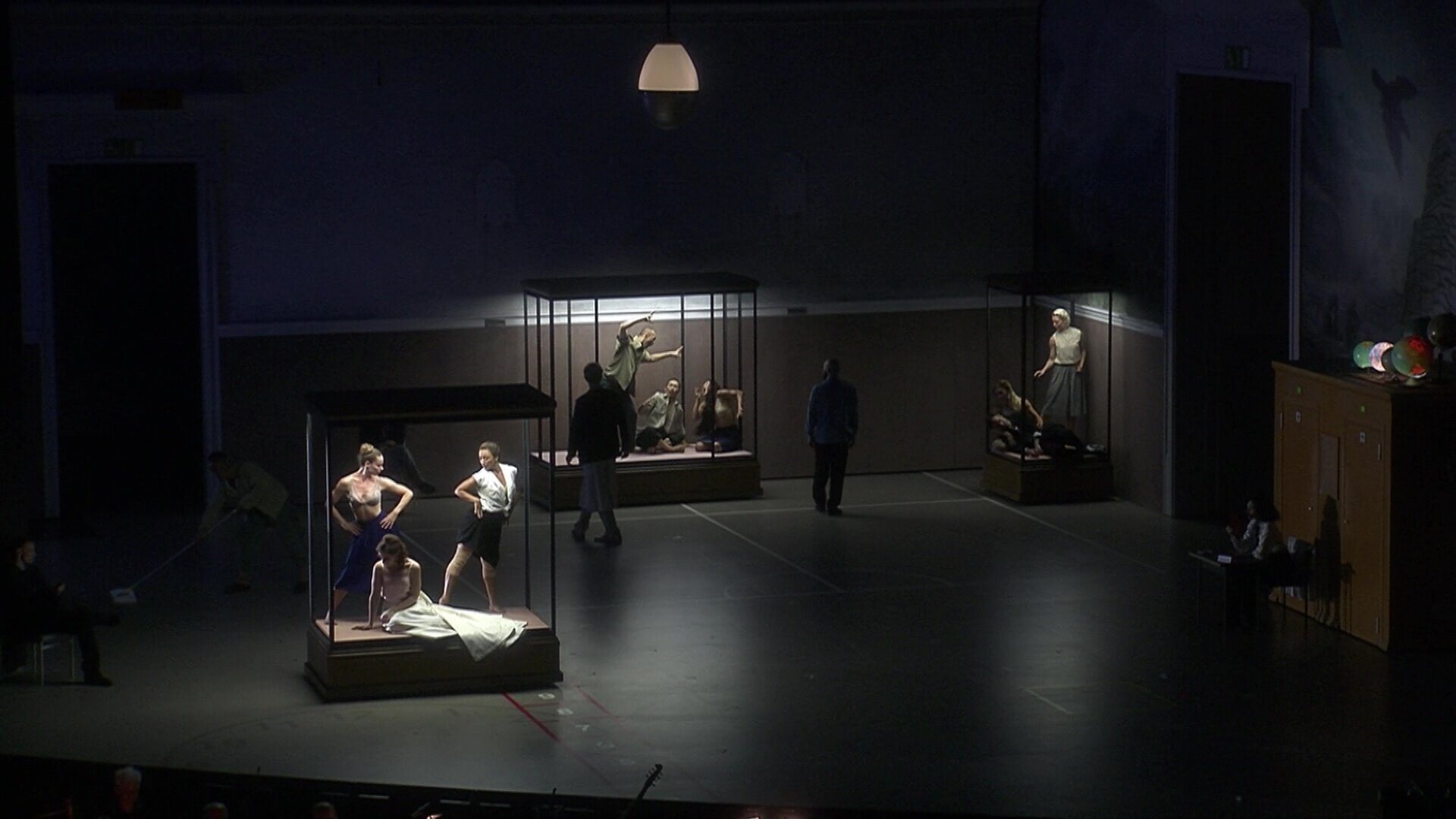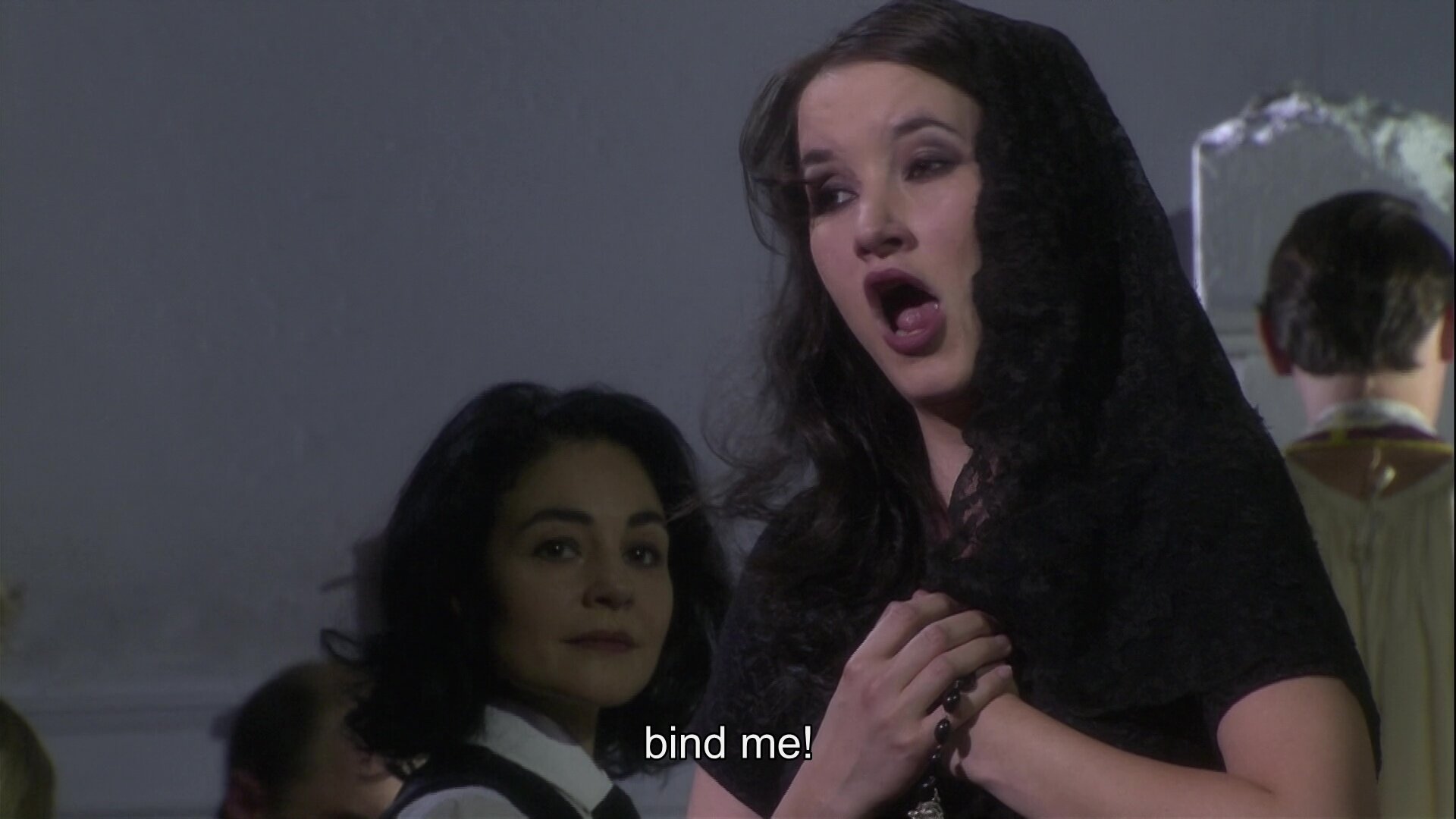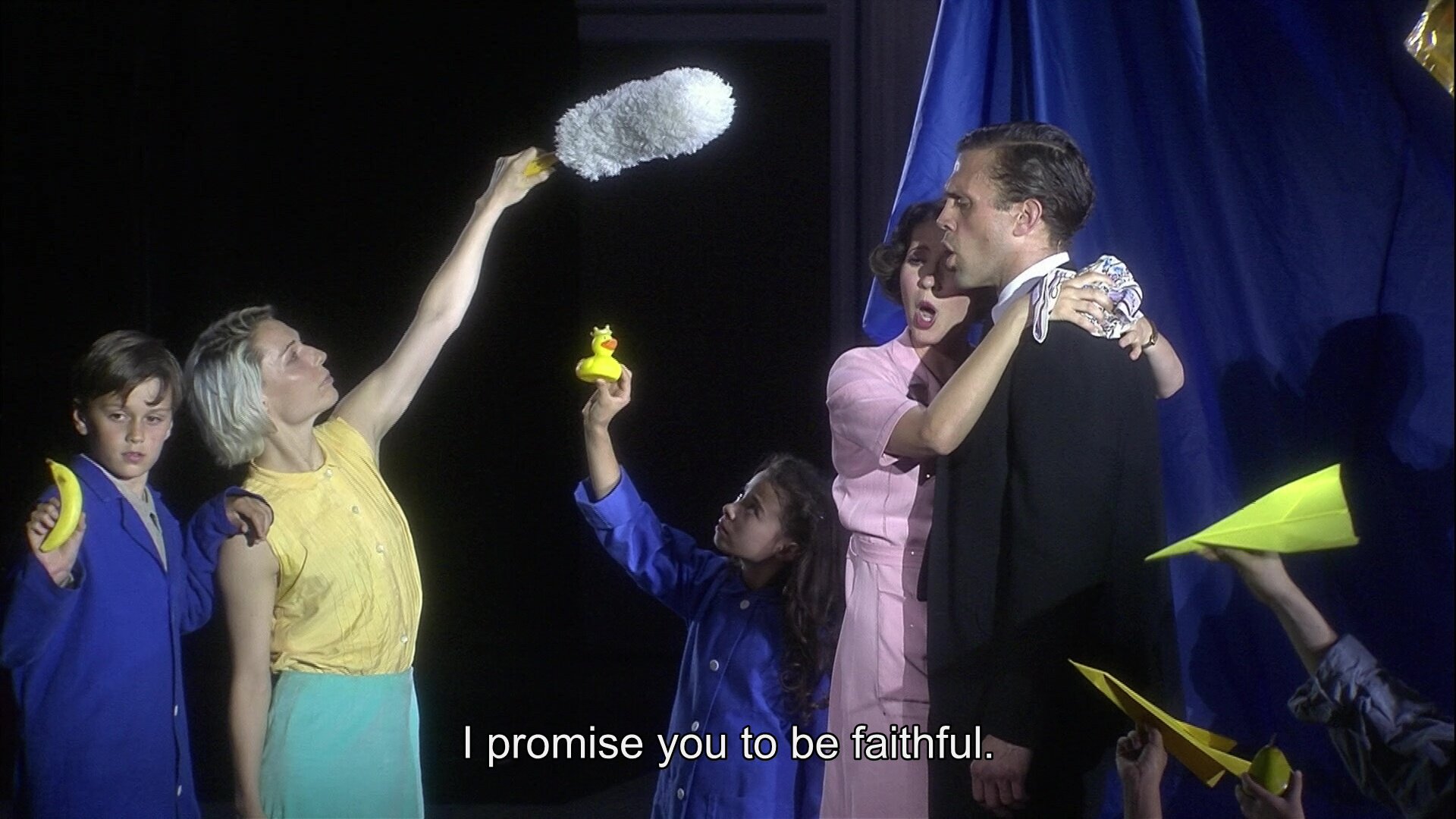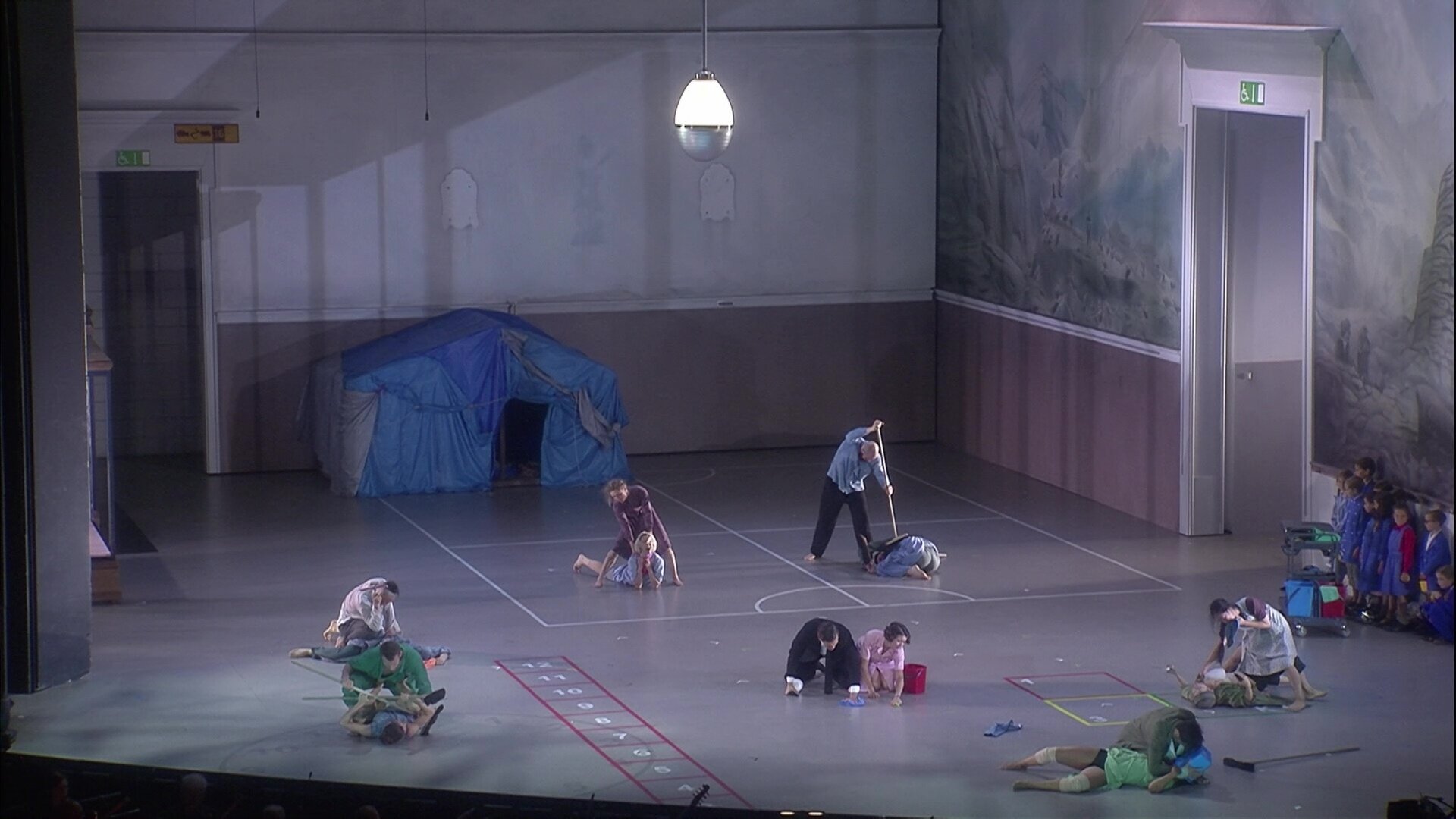
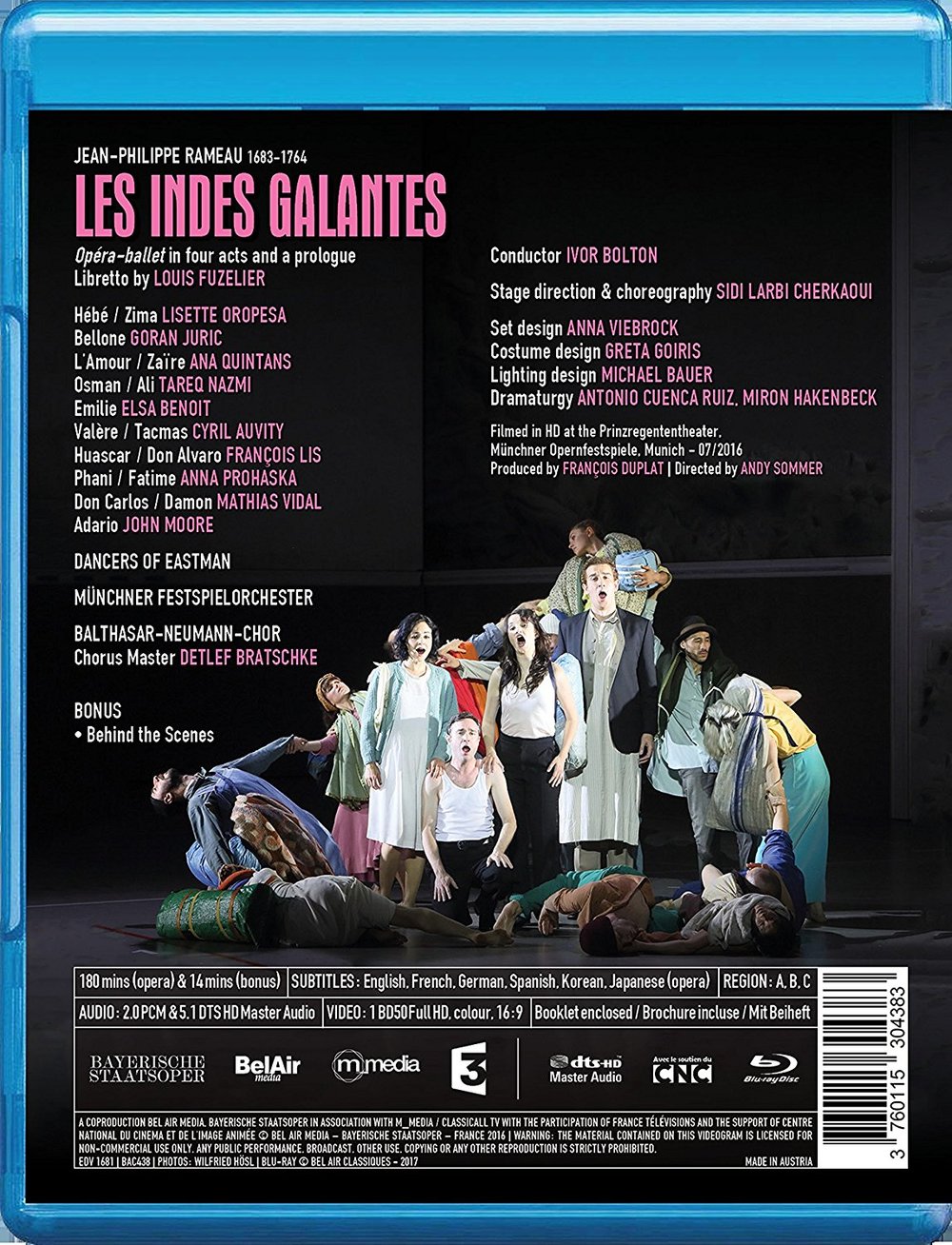
Jean-Philippe Rameau Les Indes galantes opera-ballet to a libretto by Louis Fuzelier. Directed and choreographed 2016 by Sidi Larbi Cherkaoui at the Prinzregentheater in Munich as part of the Munich Opera Festival. Stars Lisette Oropesa (Hébé/Zima), Goran Juric (Bellone), Ana Quintans (L'Amour/Zaïre), Tareq Nazmi (Osman/Ali), Elsa Benoit (Emilie), Cyril Auvity (Valère/Tacmas), François Lis (Huascar/Don Alvaro), Anna Prohaska (Phani/Fatime), Mathias Vidal (Don Carlos/Damon), and John Moore (Adario). Also features the Dancers of Eastman. Ivor Bolton conducts Munchner Festspielorchester and Balthasar-Neumann-Chor (Chorus Master Detlef Bratschke). Set design by Anna Viebrock; costume design by Greta Goiris; lighting design by Michael Bauer; dramaturgy by Antonio Cuenca Ruiz and Miron Hakenbeck. Directed for TV by Andy Sommer; produced by François Duplat. Released 2017, the disc has 5.1 dts-HD Master Audio sound output. Grade: B-
The Prologue opens in a elementary school where Hébé (Lisette Oropesa), the goddess of youth, is teaching school children about the wonders of nature. This shabby set will be used with crude props for all 4 acts to follow:
In the next screenshot below we see 10 kids and 12 Dancers of Eastlman, many of whom will be on the stage for most if not all of the show. There are also 30 members of the Balthasar-Neumann-Chor who often will enter the stage, while singing, to serve as extras in the action. All this supports 10 opera singers playing 16 roles in the epilogue and 4 acts. Each act has a discrete story to tell with different roles. This is going to be an extraordinarily complicated and busy 3 hours of opera/dance action. Since this is a rarely performed or recorded work, few people in the audience other than professional critics will know much about the plots of the 4 separate mini-operas included.
All this puts an extraordinary burden on the stage director to properly coordinate everything that happens on the stage so he can preserve the different story-telling arcs in each of the 4 acts. Otherwise, the audience will get lost in an orgy of sensory overload. Laura Scozzi was able to do this in her well-crafted and coherent version of Les Indes galantes. Here director Sidi Larbi Cherkaoui struggles and ultimately fails to come up with story-lines that are easy to follow. But a big saving grace is that the orchestra, choir, and singers perform their music so beautifully that the audience for this can enjoy the show to some degree even if baffled by what is happening on the stage. For example, in our first screenshot below, Hébé gives advice on love that is a bit advanced for the 4th-grade children in her classroom. And next the children are joined by the dancers demonstrating high-energy modern dance moves:
The plot thickens when Bellone (Goran Juric) recruits the kids to join the army:
And the chorus chimes in with a magnificent lesson in the martial arts:
Overwhelmed by Bellone, Hébé asks L’ Amour (Ana Quintans) for support. Together they recommend the children to visit 4 foreign lands to learn what love is:
The children (all of whom probably are from sophisticated, art-oriented families) seem (in what I view as a candid shot) skeptical about the whole scene before them:
Act 1. Now we have crossed a vast sea to Turkey where the protagonists are captives of pasha Osman. In the early 18th century, stories of western women forced into harems were popular in Europe. Some observers think the scene below consists of western captives on display in a public museum, which has a nice toilets with a pert attendant. But I prefer to view these showcases as captured boats. (See what I mean about the potential for audience confusion?) All the figures under spotlights are dancers except for the lady in the long skirt, who is Emilie (Elsa Benoit). Although Emilie is now his slave, pasha Osman has fallen in love with her:
Emilie is in love with Valère (Cyril Auvity), who has been looking for her all over the high seas. After Valère is shipwrecked, he falls into Osman’s hands. So now Valère finds Emilie, but he is a captive also. What a pathetic situation!
When all seems lost for our lovers, they enjoy a sudden stroke of luck. It seems pasha Osman (Tareq Nazmi) was in his youth freed from captivity himself by Valère (or maybe by Valère’s father). So in the next view below, Osman lets the lovers go. This has to be the dumbest opera plot ever. Never mind. The children ( who are seen from time to time wandering around in their uniforms) have learned a neat love lesson: be nice to everybody you meet as you never know when they might return the favor:
The choir has replaced the dancers under the lights, Valère has climbed on top of a prop, and the dancers push the “boat” out the door. I know: in opera anything goes if it works. When it doesn’t work, you just have a mess:
Act 2. Now we have crossed another vast sea to Peru. Below meet Phani (Anna Prohaska) an Inca princess who loves conquistador Carlos wearing suspenders (Mathias Vidal). This attraction is not politically correct:
The Bavarian State Opera can pay fees. In a cast of strong singers, Prohaska gets the best music to sing, reigns supreme, and gets repeated audience applause. You could justify buying this disc just to get her performance:
Phani’s problem is that the Inca High Priest (François Lis) has a crush on her. To fantastically dramatic music from Bolton’s orchestra and choir, the Priest tries to drown Carlos at a worship ceremony (in the original he causes the sacred volcano to erupt):
The lovers escape and the Priest is consumed by shame. The problem with this mini-opera is that the villain here is depicted as a Catholic priest, and my wife is Catholic. Actually, she would not be offended personally by this, but it bothers me. I wish Cherkaoui had picked on one of those Protestant megachurches where the pastor travels around in his own jet plane preaching a “success gospel.” All sorts of scandals regularly happen to those guys, including, just yesterday, a story in the newspapers about one who lost his job. Seems the preacher was was taking part in ceremonies where he watched his wife have sex with a younger business associate. In Laura Scozzi’s version of Les Indes galantes, she gets around the religion problem by depicting her Peruvian high priest as a drug lord. That’s safe as there are no drug dealers in my family:
Act 3. Our next vacation will feature a visit to an Iranian Flower Festival. I think this is the original version of the opera, which is a comedy of cross -dressing and confused identities that works out well in the end. Below you see Fatime (Anna Prohaska) dressed as a man in a turban and Tacmas (Cyril Auvity) dressed as a woman. Rather than concern myself with the silliness of this plot, I’ll turn attention to the subtitles, two of which I never quite figured out:
The flowers in this act are replaced with displaced persons played by the Dancers of Eastland. The high point of the whole production is in Act 3, Scene 7 with two quartets sung by the lovers after they get things sorted out. The quartet consists of Ali (Tareq Nazmi standing in the rear), Zaïre (Ana Quintans standing on the left), Fatima (Anna Prohaska), and Tacmas (Cyril Auvity) kneeling in front. The implication here is that if the 4 lovers can achieve stability, then the 4 million refugees will eventually find save harbor also:
Act 4. Finally we are at the end of our long trek and in North America where the Indians are settling their fight against the invading Europeans and planning on smoking the peace-pipe. Below is the Indian Princess Zima (Lisette Oropesa) who is being pursued by two European suitors, Damon (Mathias Vidal) on the left and Don Alvaro (François Lis) on the right. Eventually she decides that one of them is too loving and other not loving enough:
Zima marries her old suitor, the Indian brave Adario (John Moore) in a scene full of strange symbolism:
There then follows a long scene about the essence of marriage, which seems to be constant fighting over who does the housework:
I conclude with another candid shot of the kids at the end of the show. After being on stage at this for 3 hours, they seem to be thinking, “If this show is about the lives of the adults, what is the point of growing up?”
I found 5 reviews from critics who saw this live in Munich in in 2016. 4 were wildly enthusiastic. But someone named, I think, Giulia Tonelli wrote that the production was “awful” and the dancing mostly incoherent. According to Alexandra Coghlan, writing writing about the Blu-ray in the January 2018 Gramophone (page 91), modern themes treated are "displacement, otherness, and exile." Coghlan also comments that "the spirit behind [this show] is precisely right—Baroque divertissement reinvented as 21st-century political and social meditation, dance and music working together as one."
I agree that the music and SQ are terrific. The video and PQ are good. But the hyperactivity and obscurity of the production often irritated me. The essence of every successful opera production is the ability of the artistic team to put together a coherent package that supports a reasonably clear story line. This production is too uneven, disjointed, and complicated to pass that test. I view this as a C+ title, but out of respect for the strong singers and orchestra, I wind up at B-. Get the Indes Galantes from Laura Scozzi first if you can (it may now be out of print).
Below are two clips that show you what the production was like. The images are not from the Blu-ray recording, which looks better than the trailers:
OR






